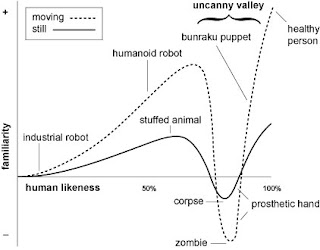It’s conquered the uncanny valley.
That’s right; everyone, even Frank from 30 Rock, was wrong about this one. The Na’vi were compelling, realistic looking, and kind of sexy at times (none of us are proud by the fact that a series of 0s and 1s on a computer database turned us on, but that’s the truth – oh, the g-strings…). CGI can now tackle humans that look, feel, and act realer than Megan Fox ever did.
But is this the ultimate goal of CGI? One of my friends suggested that CGI will finally reach its consummation when it becomes like set design or sound editing – you don’t notice it (unless it’s bad). Is that all we want? Yes, I realize I don’t really admire sound editing that much, and I only really think of great sets after seeing the movie 4 or 5 times (for example, The Rear Window). However, what about costumes? I agree that sometimes costumes are meant to blend into the scene and not draw attention away from the action. Yet, they also can be the spectacle and their flashiness and costumeness can enhance a scene or an entire movie.
Can this work with CGI though? Can we really appreciate CGI when it stands out from the rest of the film? I think so, particularly in one specific genre: horror. If you look at the diagram of the uncanny
 valley on Wikipedia, you’ll notice it isn’t about CGI. It predates that. In the valley are two things of note: corpses and zombies. So, if I’m reading this correctly, George Romero’s creatures are establishing residences in roughly the same latitude and longitude as Ringo Starr in Rockband. Why not make this work for us?
valley on Wikipedia, you’ll notice it isn’t about CGI. It predates that. In the valley are two things of note: corpses and zombies. So, if I’m reading this correctly, George Romero’s creatures are establishing residences in roughly the same latitude and longitude as Ringo Starr in Rockband. Why not make this work for us? You know what’s still scary? King Kong in the original 1933 film. He walks in a herky-jerky fashion, his fur moves randomly since the animators weren’t all that concerned with the between-shot continuity, and he’s just not of this world.
 Maybe it’s me talking from a 2010 perspective, but King Kong moves like death – like a relic from the past that has come back to haunt us. Unzombified, he is more of a walking corpse than any horror that Danny Boyle ever filmed. While I can’t speak for the 1933 audience, I would like to think that they were discerning enough to at least realize that there was a barrier between Kong and seeing a realistic looking gorilla on screen.
Maybe it’s me talking from a 2010 perspective, but King Kong moves like death – like a relic from the past that has come back to haunt us. Unzombified, he is more of a walking corpse than any horror that Danny Boyle ever filmed. While I can’t speak for the 1933 audience, I would like to think that they were discerning enough to at least realize that there was a barrier between Kong and seeing a realistic looking gorilla on screen.Why can’t we harness this bringer of fear? You want to know what was one of the most terrifying things I’ve seen recently on screen? I was channel surfing and for some reason that is lost to me, I ended up watching Alvin and the Chipmunks. Yes, the Jason Lee movie. And you wanna know what – it wasn’t terrible. It was kind of fun, in a "cheesy kids' movie" sort of way. However, there is a short moment when Dave opens his dishwasher to find a wet Alvin in it. The CGI was off and the wet chipmunk looked unnatural, disturbing, and made me jump for a moment in my seat. A mistake? Undoubtably. Certainly, this reaction was not the intended one of the film makers. But hasn’t art always been about using accidents and transfiguring the mishap into serendipity? My abjection, my unnerving was there. There’s an easy way to tap into it; this way is far easier and far more guaranteed than billions dollars worth of computer generated blood, monsters, or severed limbs…because they all just look too natural.
I leave you with this thought: think of a zombie chasing a human. Now think of the same human being chased by a zombie…except now the zombie is the festering cadaver of Andy from the first Toy Story. Inhuman, early CGI Andy. Maybe missing an arm or half a skull.
Chilling, isn’t it?





